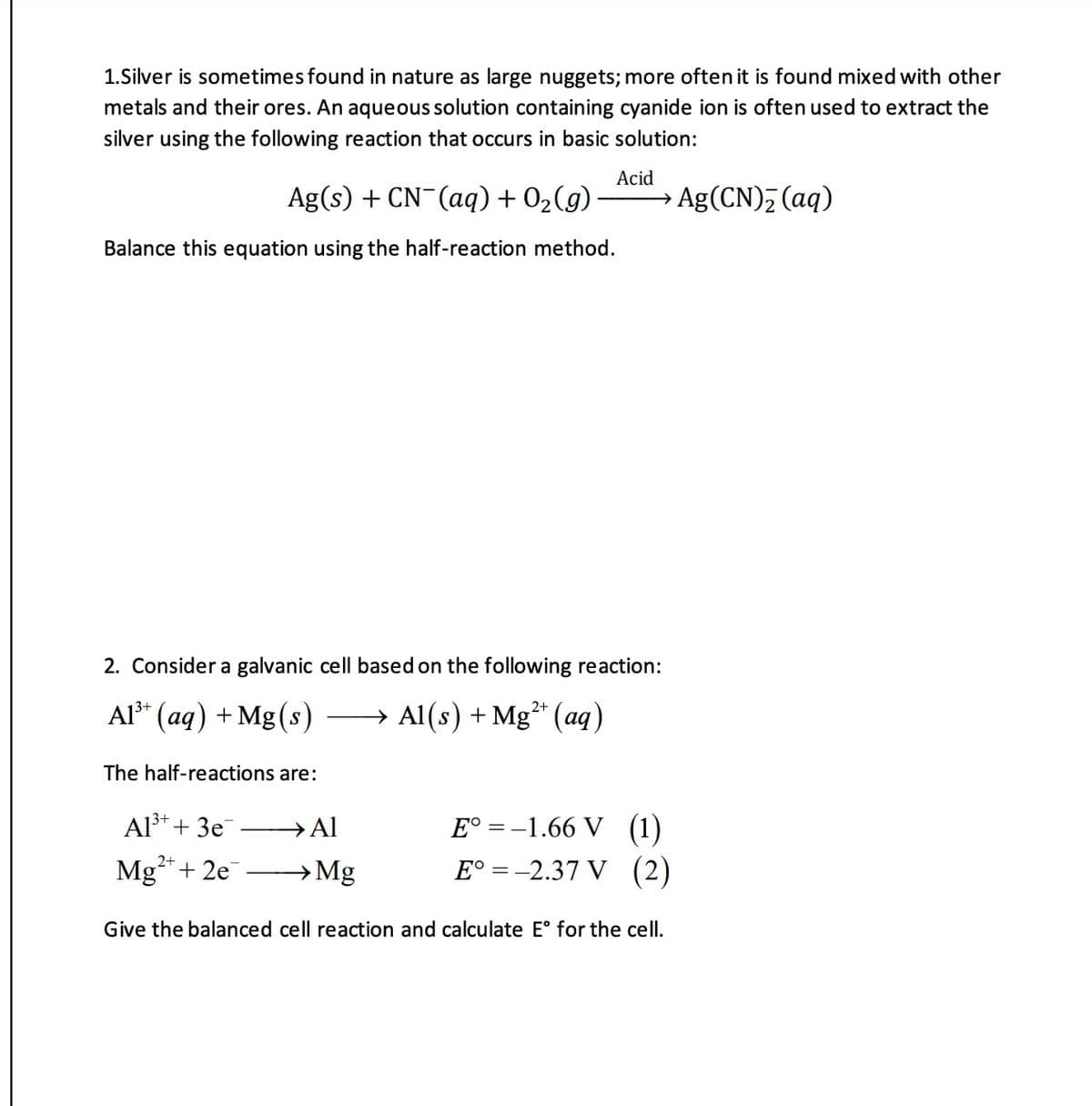1.Silver is sometimes found in nature as large nuggets; more often it is found mixed with other metals and their ores. An aqueous solution containing cyanide ion is often used to extract the silver using the following reaction that occurs in basic solution: Acid Ag(s) + CN¯(aq) + 02(g) Ag(CN), (aq) Balance this equation using the half-reaction method.
1.Silver is sometimes found in nature as large nuggets; more often it is found mixed with other metals and their ores. An aqueous solution containing cyanide ion is often used to extract the silver using the following reaction that occurs in basic solution: Acid Ag(s) + CN¯(aq) + 02(g) Ag(CN), (aq) Balance this equation using the half-reaction method.
Chemistry & Chemical Reactivity
10th Edition
ISBN:9781337399074
Author:John C. Kotz, Paul M. Treichel, John Townsend, David Treichel
Publisher:John C. Kotz, Paul M. Treichel, John Townsend, David Treichel
Chapter19: Principles Of Chemical Reactivity: Electron Transfer Reactions
Section19.9: Corrosion: Redox Reactions In The Environment
Problem 2.5ACP: Assume the following electrochemical cell simulates the galvanic cell formed by copper and zinc in...
Related questions
Question
( do 1st one with explanation

Transcribed Image Text:1.Silver is sometimes found in nature as large nuggets; more often it is found mixed with other
metals and their ores. An aqueous solution containing cyanide ion is often used to extract the
silver using the following reaction that occurs in basic solution:
Acid
Ag(s) + CN¯(aq) + 02(g)
Ag(CN), (aq)
Balance this equation using the half-reaction method.
2. Consider a galvanic cell based on the following reaction:
Al* (aq) + Mg(s)
→ Al(s) + Mg** (aq)
The half-reactions are:
Al³* + 3e -→Al
E° = –1.66 V (1)
E° = -2.37 V (2)
Mg**+ 2e
→Mg
Give the balanced cell reaction and calculate E° for the cell.
Expert Solution
This question has been solved!
Explore an expertly crafted, step-by-step solution for a thorough understanding of key concepts.
This is a popular solution!
Trending now
This is a popular solution!
Step by step
Solved in 2 steps with 2 images

Knowledge Booster
Learn more about
Need a deep-dive on the concept behind this application? Look no further. Learn more about this topic, chemistry and related others by exploring similar questions and additional content below.Recommended textbooks for you

Chemistry & Chemical Reactivity
Chemistry
ISBN:
9781337399074
Author:
John C. Kotz, Paul M. Treichel, John Townsend, David Treichel
Publisher:
Cengage Learning

Chemistry
Chemistry
ISBN:
9781305957404
Author:
Steven S. Zumdahl, Susan A. Zumdahl, Donald J. DeCoste
Publisher:
Cengage Learning

Chemistry: An Atoms First Approach
Chemistry
ISBN:
9781305079243
Author:
Steven S. Zumdahl, Susan A. Zumdahl
Publisher:
Cengage Learning

Chemistry & Chemical Reactivity
Chemistry
ISBN:
9781337399074
Author:
John C. Kotz, Paul M. Treichel, John Townsend, David Treichel
Publisher:
Cengage Learning

Chemistry
Chemistry
ISBN:
9781305957404
Author:
Steven S. Zumdahl, Susan A. Zumdahl, Donald J. DeCoste
Publisher:
Cengage Learning

Chemistry: An Atoms First Approach
Chemistry
ISBN:
9781305079243
Author:
Steven S. Zumdahl, Susan A. Zumdahl
Publisher:
Cengage Learning


Chemistry: Matter and Change
Chemistry
ISBN:
9780078746376
Author:
Dinah Zike, Laurel Dingrando, Nicholas Hainen, Cheryl Wistrom
Publisher:
Glencoe/McGraw-Hill School Pub Co

Chemistry: Principles and Reactions
Chemistry
ISBN:
9781305079373
Author:
William L. Masterton, Cecile N. Hurley
Publisher:
Cengage Learning